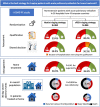Triaging acute pulmonary embolism for home treatment by Hestia or simplified PESI criteria: the HOME-PE randomized trial
- PMID: 34363386
- PMCID: PMC8408662
- DOI: 10.1093/eurheartj/ehab373
Triaging acute pulmonary embolism for home treatment by Hestia or simplified PESI criteria: the HOME-PE randomized trial
Abstract
Aims: The aim of this study is to compare the Hestia rule vs. the simplified Pulmonary Embolism Severity Index (sPESI) for triaging patients with acute pulmonary embolism (PE) for home treatment.
Methods and results: Normotensive patients with PE of 26 hospitals from France, Belgium, the Netherlands, and Switzerland were randomized to either triaging with Hestia or sPESI. They were designated for home treatment if the triaging tool was negative and if the physician-in-charge, taking into account the patient's opinion, did not consider that hospitalization was required. The main outcomes were the 30-day composite of recurrent venous thrombo-embolism, major bleeding or all-cause death (non-inferiority analysis with 2.5% absolute risk difference as margin), and the rate of patients discharged home within 24 h after randomization (NCT02811237). From January 2017 through July 2019, 1975 patients were included. In the per-protocol population, the primary outcome occurred in 3.82% (34/891) in the Hestia arm and 3.57% (32/896) in the sPESI arm (P = 0.004 for non-inferiority). In the intention-to-treat population, 38.4% of the Hestia patients (378/984) were treated at home vs. 36.6% (361/986) of the sPESI patients (P = 0.41 for superiority), with a 30-day composite outcome rate of 1.33% (5/375) and 1.11% (4/359), respectively. No recurrent or fatal PE occurred in either home treatment arm.
Conclusions: For triaging PE patients, the strategy based on the Hestia rule and the strategy based on sPESI had similar safety and effectiveness. With either tool complemented by the overruling of the physician-in-charge, more than a third of patients were treated at home with a low incidence of complications.
Keywords: Clinical decision-making; Emergency department; Home treatment; Pulmonary embolism; Randomized controlled trial; Risk assessment.
© The Author(s) 2021. Published by Oxford University Press on behalf of the European Society of Cardiology.
Figures



Comment in
-
Home management or hospital admission for low-risk pulmonary embolism? Clinical scores versus pragmatic assessment.Eur Heart J. 2021 Aug 31;42(33):3158-3160. doi: 10.1093/eurheartj/ehab491. Eur Heart J. 2021. PMID: 34387674 No abstract available.
-
In acute PE, triage for home treatment using the Hestia rule vs. sPESI was noninferior for 30-d clinical outcomes.Ann Intern Med. 2022 Jan;175(1):JC7. doi: 10.7326/J21-0010. Epub 2022 Jan 4. Ann Intern Med. 2022. PMID: 34978857
References
-
- Konstantinides SV, Meyer G, Becattini C, Bueno H, Geersing GJ, Harjola VP, Huisman MV, Humbert M, Jennings CS, Jimenez D, Kucher N, Lang IM, Lankeit M, Lorusso R, Mazzolai L, Meneveau N, Ni Ainle F, Prandoni P, Pruszczyk P, Righini M, Torbicki A, Van Belle E, Zamorano JL; ESC Scientific Document Group. 2019 ESC Guidelines for the diagnosis and management of acute pulmonary embolism developed in collaboration with the European Respiratory Society (ERS). Eur Heart J 2020;41:543–603. - PubMed
-
- Kearon C, Akl EA, Ornelas J, Blaivas A, Jimenez D, Bounameaux H, Huisman M, King CS, Morris TA, Sood N, Stevens SM, Vintch JRE, Wells P, Woller SC, Moores L. Antithrombotic therapy for VTE disease: CHEST guideline and expert panel report. Chest 2016;149:315–352. - PubMed
-
- Maughan BC, Frueh L, McDonagh MS, Casciere B, Kline JA. Outpatient treatment of low-risk pulmonary embolism in the era of direct oral anticoagulants: a systematic review. Acad Emerg Med 2021;28:226–239. - PubMed

